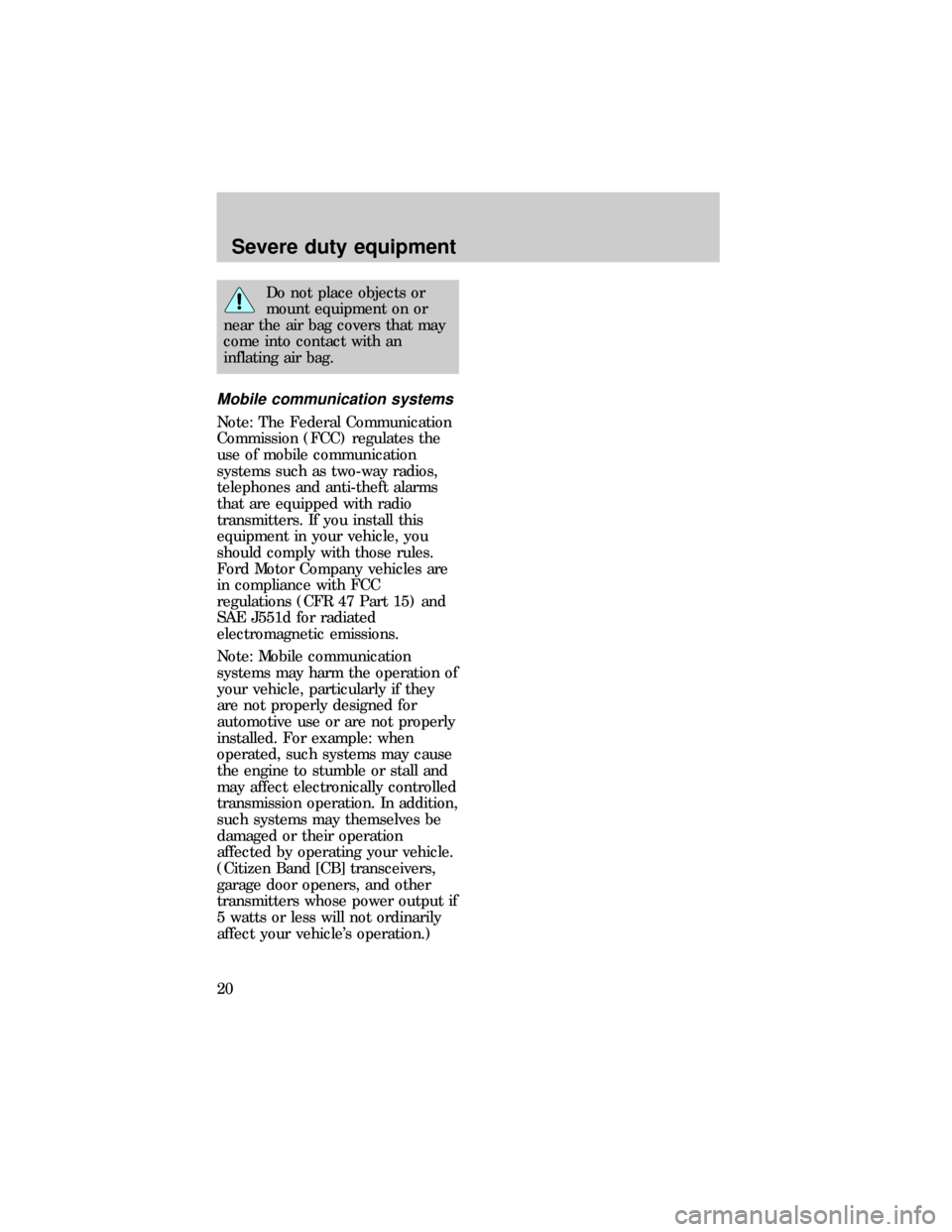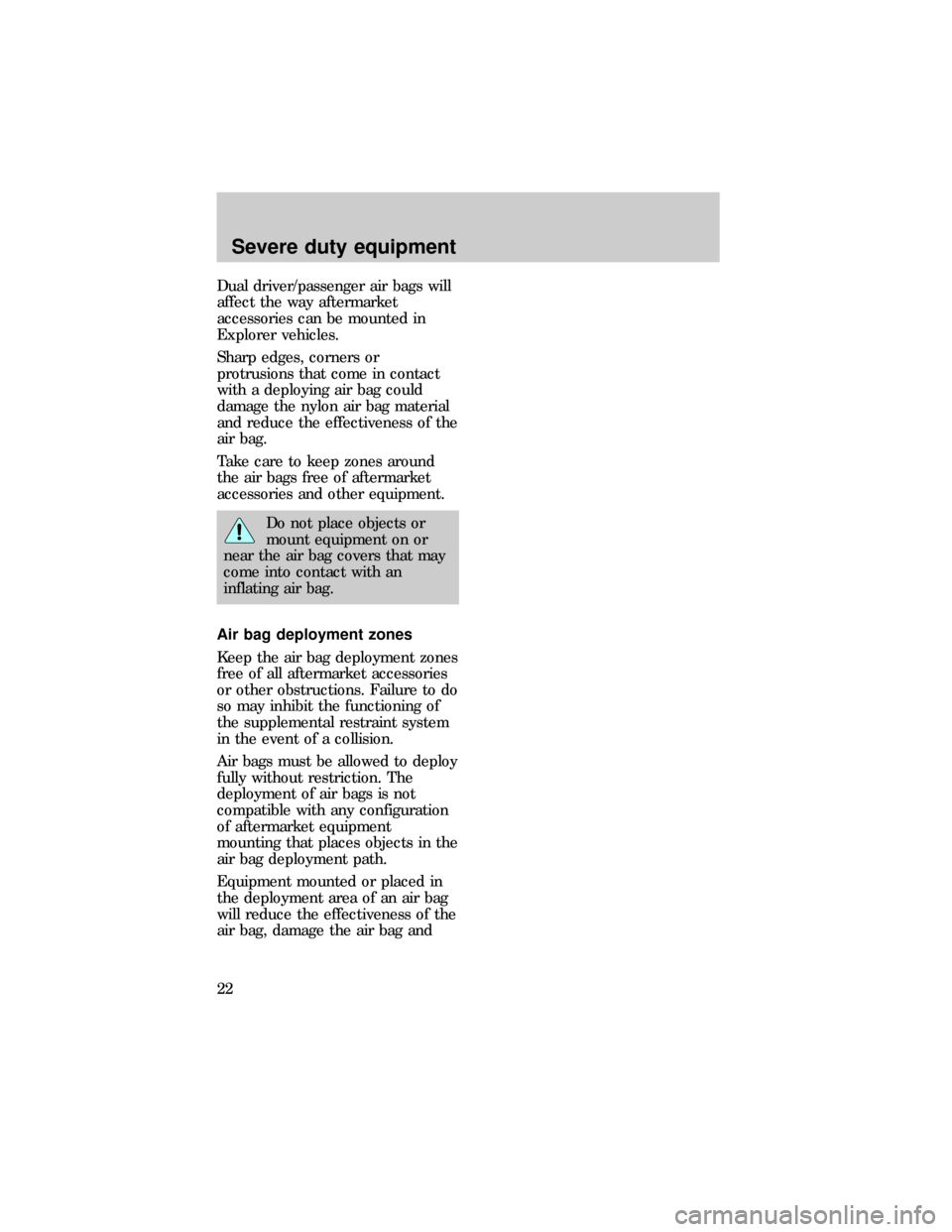Page 17 of 28
Chassis lubrication intervals
Chassis lubrication should be
performed every 5,000 km (3,000
miles).
Wheel bearings
No wheel bearing adjustment is
required for either front or rear
wheels.
Maintenance recommendations
17
Page 18 of 28

SPECIAL SERVICE EQUIPMENT
The Explorer is not designed
nor intended to be used as a
pursuit vehicle or an
ambulance.
The following optional equipment
is designed to meet Ford
Corporate Product Standards;
however, the equipment does not
meet corporate guidelines relative
to police packages. therefore, the
optional equipment is intended for
use in limited law enforcement
services only. Use of DSO special
service options does not imply nor
allow use as a pursuit vehicle.
Components that are part of some
available options are listed below
and on the following pages, along
with a brief outline of their major
features.
ELECTRICAL
Heavy-duty alternator
Handling the high electrical loads
imposed on special service vehicles
by the broad range of necessary
equipment requires a high ampere
output alternator.
The 4.0 L SOHC or 5.0 L Explorer
engine, when equipped with a 130
ampere alternator, has the voltage
regulator integral with the
alternator. No external voltage
regulator is required.
Severe duty equipment
18
Page 19 of 28

Heavy-duty battery special
service
Special service vehicles are
equipped with a maintenance-free
battery which does not require the
addition of water or other regular
service.
Installing aftermarket equipment
When installing aftermarket
equipment, avoid using fasteners
that are too long for the
application or are in an area that
might damage other vehicle
components (i.e., wiring, brake
lines, fuel tank and lines,
powertrain components exhaust
system, suspension, etc.).
Do not make electrical connections
to vehicle electrical systems not
specifically designed for
aftermarket equipment installation.
Do not install and components into
the Powertrain control module
(PCM) harness. Connecting into
this system may affect engine and
transmission operation. As an
example, connection of
aftermarket electrical equipment
into the brake light circuit or any
other circuit which is connected to
the PCM, anti-lock brake
computer, air bag system,
transmission or any other vehicle
system may cause vehicle
malfunction.
Severe duty equipment
19
Page 20 of 28

Do not place objects or
mount equipment on or
near the air bag covers that may
come into contact with an
inflating air bag.
Mobile communication systems
Note: The Federal Communication
Commission (FCC) regulates the
use of mobile communication
systems such as two-way radios,
telephones and anti-theft alarms
that are equipped with radio
transmitters. If you install this
equipment in your vehicle, you
should comply with those rules.
Ford Motor Company vehicles are
in compliance with FCC
regulations (CFR 47 Part 15) and
SAE J551d for radiated
electromagnetic emissions.
Note: Mobile communication
systems may harm the operation of
your vehicle, particularly if they
are not properly designed for
automotive use or are not properly
installed. For example: when
operated, such systems may cause
the engine to stumble or stall and
may affect electronically controlled
transmission operation. In addition,
such systems may themselves be
damaged or their operation
affected by operating your vehicle.
(Citizen Band [CB] transceivers,
garage door openers, and other
transmitters whose power output if
5 watts or less will not ordinarily
affect your vehicle's operation.)
Severe duty equipment
20
Page 21 of 28
Note: Because Ford has no control
over the installation, design or
manufacture of such systems, Ford
cannot assume responsibility for
any adverse effects or damage that
may result if this equipment is
used.
Malfunction of aftermarket
electronic equipment should be
resolved by the equipment
manufacturer.
Roof Wiring Preparation
Package
Be sure to locate wires in the roof
before drilling. This will prevent
damage to the wire harness or
interior headliner and ensure
proper wire routing when installing
aftermarket accessories.
AIR BAGS
The Explorer incorporates dual
standard (driver and passenger)
air bag supplemental restraint
systems.
EOFF
0020406080100
120
140
160
180
200P RND21000000oooo
km/hUNLEADED
FUEL ONLY
RPM x 100012345
6H
C
EF
RSM
SET
ACC
COAST OFF ONOFF
SRS
HI LOOFF*A/C*MAX
A/C
REW
1FF
2SIDE 1-2
3
FM 1STVOL – PUSH ON
AM
FMBASS TREBBAL FADE
AUTO
SET CLK
SEEKTUNE
DISCSSCAN4DOLBY SYSTEMEJTAPE CDCOMP5SHUFFLE
6
PUSH
Severe duty equipment
21
Page 22 of 28

Dual driver/passenger air bags will
affect the way aftermarket
accessories can be mounted in
Explorer vehicles.
Sharp edges, corners or
protrusions that come in contact
with a deploying air bag could
damage the nylon air bag material
and reduce the effectiveness of the
air bag.
Take care to keep zones around
the air bags free of aftermarket
accessories and other equipment.
Do not place objects or
mount equipment on or
near the air bag covers that may
come into contact with an
inflating air bag.
Air bag deployment zones
Keep the air bag deployment zones
free of all aftermarket accessories
or other obstructions. Failure to do
so may inhibit the functioning of
the supplemental restraint system
in the event of a collision.
Air bags must be allowed to deploy
fully without restriction. The
deployment of air bags is not
compatible with any configuration
of aftermarket equipment
mounting that places objects in the
air bag deployment path.
Equipment mounted or placed in
the deployment area of an air bag
will reduce the effectiveness of the
air bag, damage the air bag and
Severe duty equipment
22
Page 23 of 28
potentially damage or dislodge the
equipment.
Refer to the following chart before
adding aftermarket accessories or
mounting any equipment to your
vehicle for approximate mounting
zones:
Severe duty equipment
23
Page 24 of 28
Vehicle area Equipment mounting zone
Area on tunnel between seatsADo not exceed height of 254 mm
(10 inches)
BDo not exceed width of 203 mm
(8 inches)
Driver side air bag (deployed)C330 mm (13 inches) radius from
center of air bag door.
Passenger air bag (deployed)D330 mm (13 inches) radius from
center of air bag door.
E889 mm (35 inches) width.
Passenger air bag (deployed)F335 mm (14 inches) depth.
G660 mm (26 inches) height.
AB
HI LO
DOLBY SYSTEM
0
C
D
E
F
Severe duty equipment
24